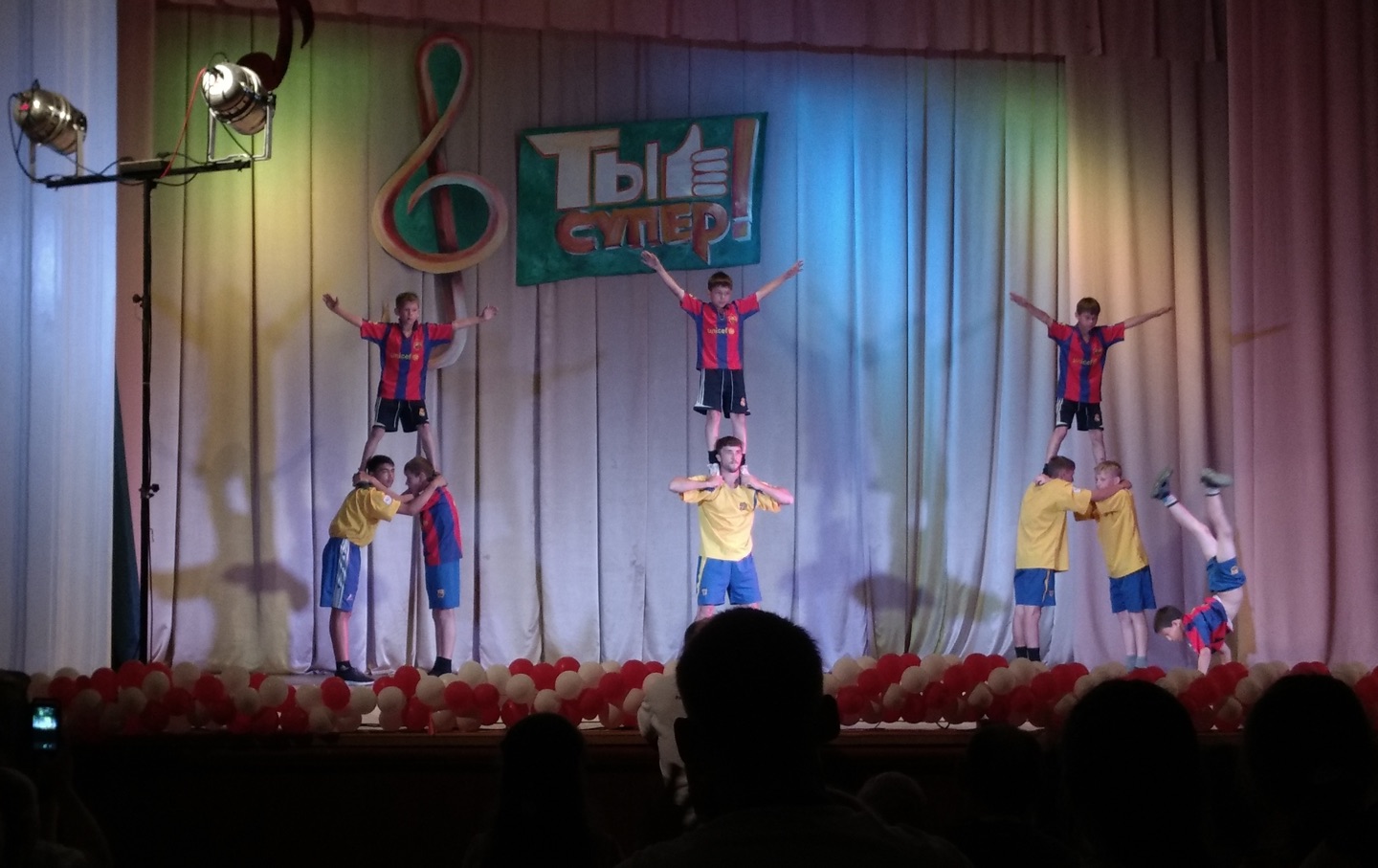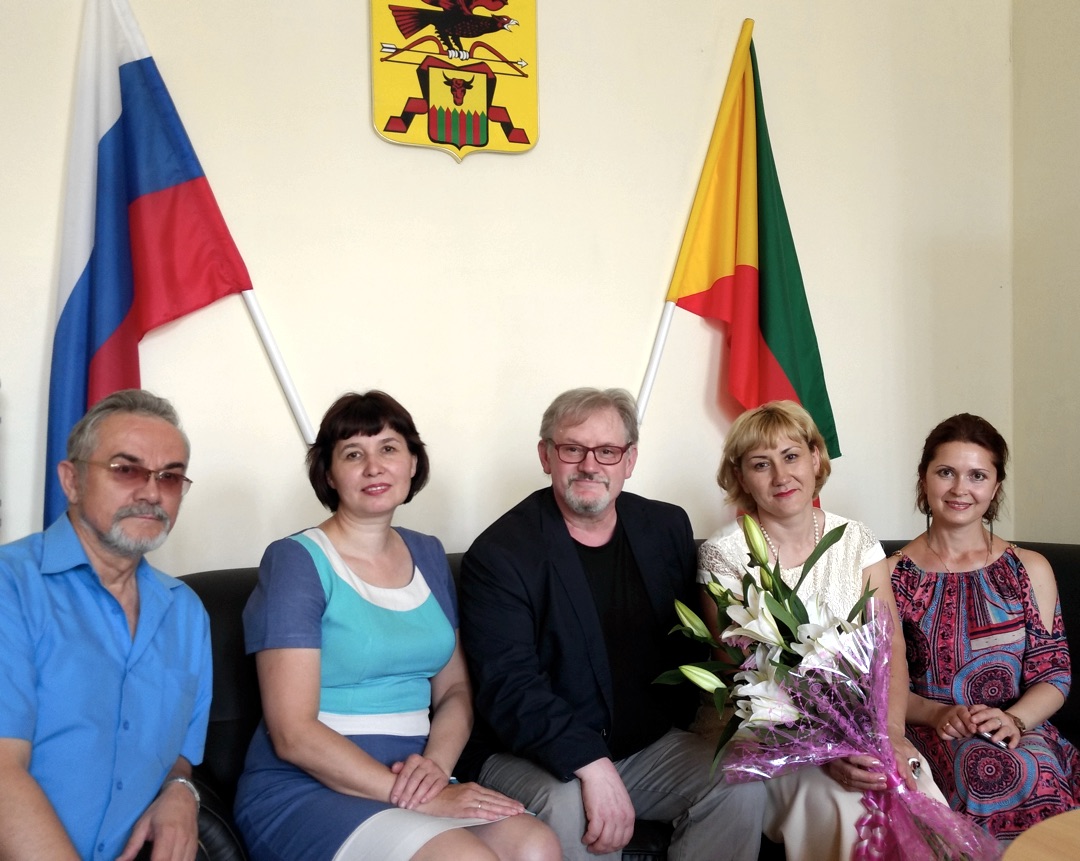Summer in Chita 2018 No. 8 Krasny Chikoy festival
August 17-19, I was invited by the Zabaikalsky Krai Department of Tourism to tag along with a Chinese music group going to Krasny Chikoy to participate in a folk music festival there. Krasny Chikoy is a small remote town located in the far southwestern corner of the Krai near the Amur River, one of the great rivers of the world, which forms the border with Mongolia. The town is the gateway to the Chikoy National Park.
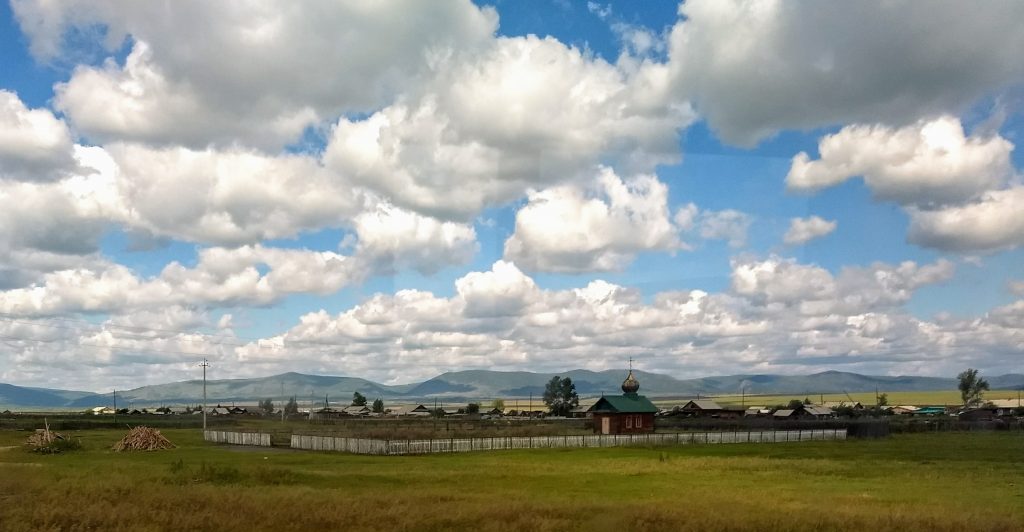
A village on National Hwy 6 between Chita and Petrovsk-Zabaikalsky viewed from the bus
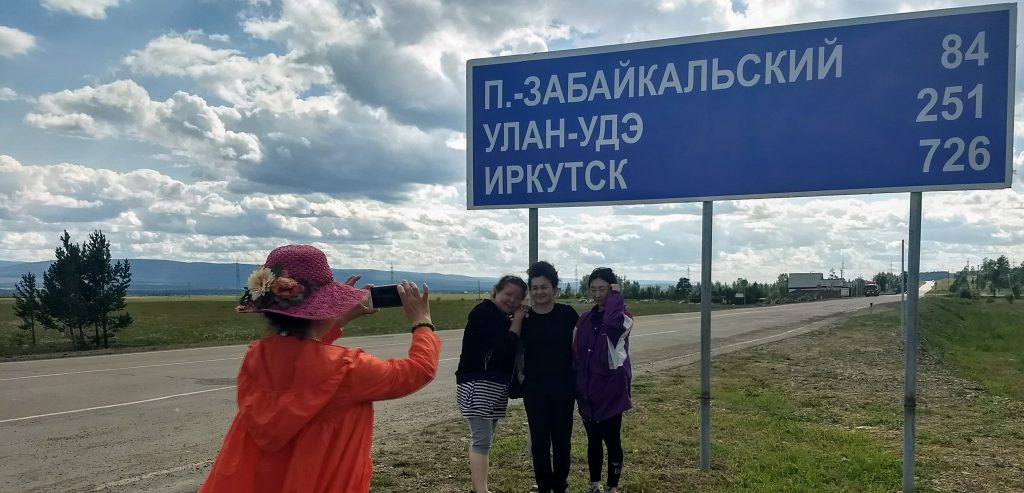
Some of the Chinese singing group posing under a sign that says Petrovsk-Zabaikalsky is 84 km away, Ulan Ude is 251 km away, and Irkutsk is 726 km away. (Krasny Chikoy is two hours of unpaved road beyond Petrovsk-Zab.) From an American’s perspective, we are out there!
The bus ride was about 8 hours long, the last two hours spent bouncing along on a mostly dirt road with numerous small wooden bridges crossing streams for which the bus had to come to nearly a full stop to bump its way over them. This road was in the narrow flat valley of a meandering river surrounded by small mountains. Though the trees and grasses generally looked like those of our western states, the size and closeness of the hills and winding way of the road often reminded me of Vermont. Along this road hay was being cut, dried and raked into haystacks. Though I saw a couple of tractors, most cutting was done with gas-powered weed-whackers, and the dry hay was hand-raked by teams of 3-10 people. It felt like I was looking out the bus window into a scene 100 years old and older. I even saw a man raking who was wearing a traditional Russian side-buttoned white tunic. We also passed a large long fields of cabbages being harvested by hand.
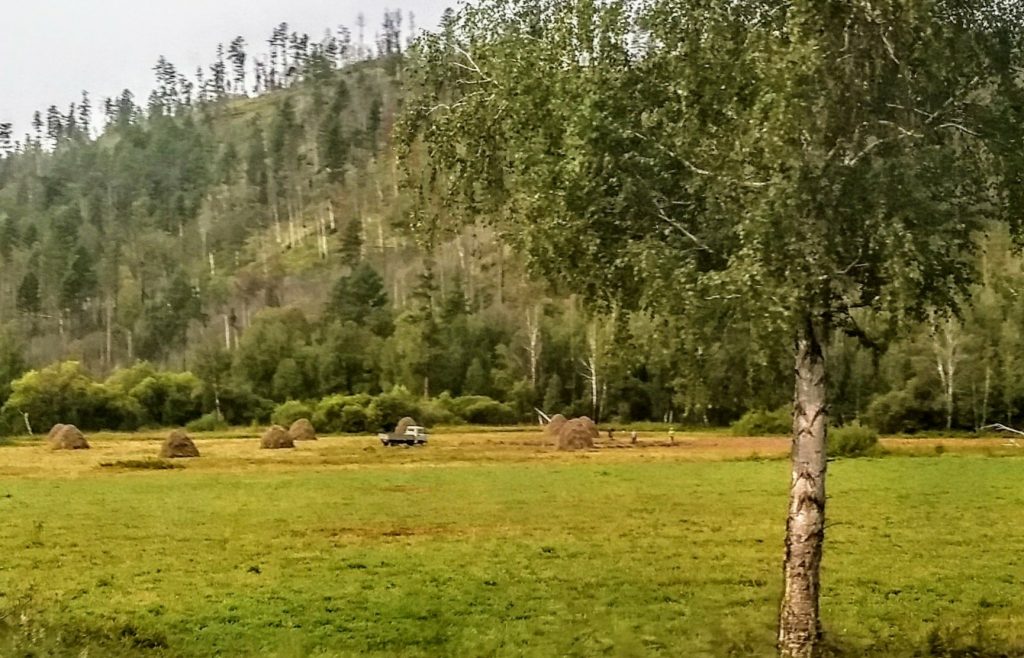
On the road to Krasny Chikoy teams were raking hay into stacks

A small lake on the road from Petrovsk-Zab. to Krasny Chikoy
The Chinese singing group “???????” (Zemlyaky: Countrymen) was from the small city of Erguna (Hulunbuir administration in Inner Mongolia in a district along the Russian border. I recommend looking it up in Google Maps–there are pictures and you can see the Russian influence.) We joined them in Chita at 9am on Friday, presumably following an all day bus ride north into Russia for them and an overnight stay along the route. (Looking at the map I guess the bus ride to be 10-12 hours to Chita.) We stopped only for toilet and cigarette breaks. The odor of those cigarettes is different than American ones and I must say it was somewhat nostalgic for me, reminding me of my piano tours in China in the late 1980s and early 1990s… and also of my long ago smoking days, too! We made one late lunch stop at a roadside truck stop where the table was all set for us: salad, blini with sweetened condensed milk, borsch and Buryat meat dumplings (posi). At a couple of moments the group sang on the bus. The bus was very noisy, but no matter. Sasha, one of the Chinese men, pulled out his accordion and accompanied.
This embedded video is a capture of the news segment about the festival, the Chinese guests…and the American, too.
Besides me, the other non-singers were, Irina, the Dept of Tourism leader (who never stopped working!), Vladimir Lyashenko, a reporter for TV Channel 1 in Chita (see his report in Russian in the video just above), Ksenia and Maxim, staff members of the Natural History Museum in Chita, Natasha, a tour agent from a private tourism company in Chita, and our two interpreters, Elena Pishcherskaya for English for me, and Alyona Komogortseva, Chinese linguist and new teacher alongside Elena at the Chita Institute this fall (and the Chinese interpreter for the Chita group in the tri-country student video conference last November on International Student’s Day.)
Most of the nine women and two men of Zemlyaky, plus the leader of the group (from the town’s Dept of Culture?) and a cameraman, had Russian ancestry. Alyona asked about their background. They said that White Russians left Russia for Mongolia during the civil war just after the revolution, and more came across the next several decades. In 1953, this town of Erguna was 85% Russian. You could see the mix of Slavic and Chinese features in their faces, eyes, even their hair. Elena was surprised how pure their Russian was, but Alyona was told their parents and they preserved the language and traditions. The group sang old Russian folk songs and also songs in Chinese.
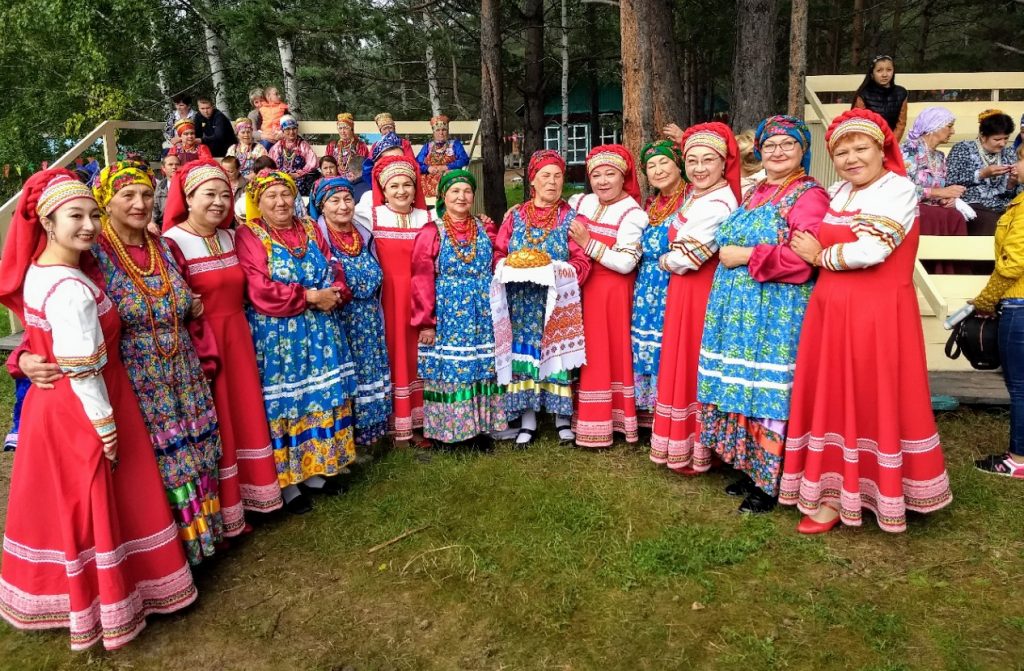
A warm welcome for ??????? from Erguna, China (those in red) by some of the ladies at the festival.
This was the “Fifth International Festival of Culture of the Old Believers entitled ‘Family Circle’” (V ????????????? ????????? ???????? ?????????-????????????? “????????? ????????”). The Old Believers are a religious group who, like the Amish in the United States, rejected their main church’s reforms and dictates and moved away (were exiled) from their native communities. And like our Amish, they live an agrarian life of old, simple ways in closed communities. Seeing Old Believers is like a glimpse of 17th century village life in Russia. This festival’s purpose is to celebrate, preserve and revive these traditions—crafts and songs, largely. UNESCO lists the Old Believers as a world cultural treasure and a letter from UNESCO supporting the festival was read at the opening ceremonies.
We only attended the 2nd of the three days of the festival, the day of the song contest. Groups from across Russia came, though mostly from Zabaikalsky Krai and neighboring Buryatia. The honored guests were the Chinese group and they received a special welcome. I was asked to play a piano piece, outside of the contest, of course, and this stray, unexpected American added a little more internationalness to the proceedings.
The day began at 9am with a babushka (old woman, grandmother) in Old Believer garb, telling a long story. She was eventually joined by several others like her, who entered from backstage in the large outdoor music shell singing softly and crescendoing to the point that the first woman joined in the song. They then enacted a picnic on the stage, singing a couple more songs with some of them commenting, and then, packing up their picnic cloth and things, slowly wended their way off-stage.
Elena was laughing as the woman told her story, and I saw that other members of the audience were, too. Elena said that her idiomatic speech was strictly of the Zabaikalyan region and it was charming to hear these old rural sounds.
A portion of the opening skit (4:42)
This was followed by a song and another presentation and then representatives from the singing groups were brought forward one at a time, most presenting beautifully decorated bread on a lace or embroidered cloth, a traditional greeting. Following speeches by the region’s Administrator, the Krai’s Minister of Culture and the founder of the festival, the Chinese group was given its special welcome onstage with speeches and gifts exchanged.
This opening of the festival’s contest ended with a ceremonial dance version of the “Family Circle” that is the festival’s name. All of us joined hands, and, to lively accordion or bayan (Russian variant of the accordion) music, we danced slowly in lines, forming seven or eight close concentric rings of dancing on the grass in front of the stage. It was wonderful.
NOTE: I was told the actual meaning of “family circle” is likely more the small ad hoc gatherings of people in the forest (at this children’s camp taken over by the festival for these days) for song, for story, for the playing of musical spoons!, for eating, for crafts. All across the day and evening we heard song through the trees and people sitting or standing together in their costumes, though for some this was their normal garb being actual Old Believers! and creating a friendly and welcoming atmosphere. When we left the next morning after breakfast, the Chinese guests were sent on their way with songs and hugs, and they seemed thrilled by the short visit and the warm welcome.
Vladimir from the TV channel, interviewed me for radio during the bus trip, and asked if I would be willing to be recorded on video being taught how to make blini by some Old Believer babushky. Such a question. Who would pass this up? So some minutes after the song contest began, he found me and we went to picnic table whose every inch was covered with bowls of new potatoes, eggs, salt cured mushrooms, fresh berries with sugar, sausage and salo (salt and garlic cured pork fatback), bread and buns, cucumber pickles and fresh cucumbers and tomatoes and jams of many sorts, and, of course, blini. These were large raised blini cut into quarters. Seated at the table were by six babushky in their bright headdresses and skirts with one last place saved for me. To the side were two men, one with a garmoshka (small accordion) and the other singing with more babuskhy standing nearby. As I arrived, all were engage in a rich cheerful song.
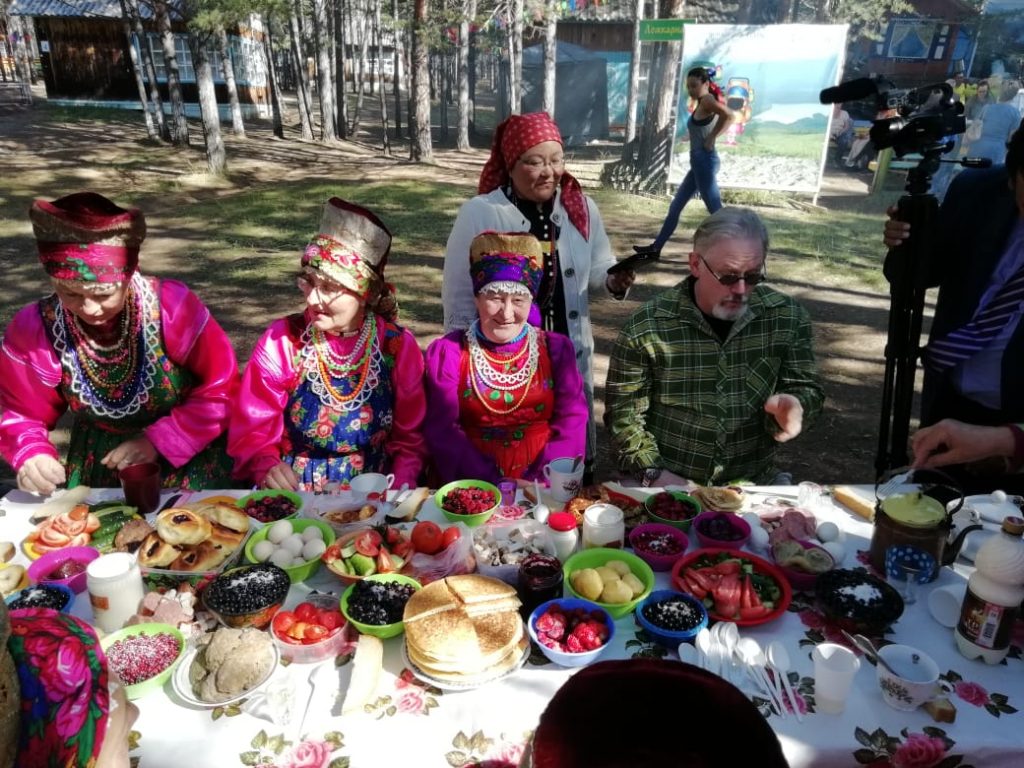
With the ladies from Archangeloskoye. There would soon be a little toasting, a little dancing, and a lot of singing.
Then one of the ladies addressed me, welcoming and thanking me for my interest in their life. And then she did the standard Russian thing of pushing food on guests and I tried the blini with smetana and jam, a mushroom, some potato, the pickles (I was quite willing to stay and chow down. The food, especially the berries which just came into season, was fantastic.) But then she brought out a teapot that contained samagon—home distilled spirits—and several of us toasted. Kindly, they had not filled the teapot very full, so only three toasts (the crucial three) were possible, and for the last there was a lovely effort to fill my small glass up with samagon from the others, after which I poured some back to make them all even.
This was typically strong homemade spirits, and three toasts had an effect! There was more song, and soon the hostess asked me to dance with them. It was embarrassing that I couldn’t even find the beat (damned liquor!), but was told no matter—don’t I know that much of this dancing is done with, and inspired by, a bit of drinking?
You’ll notice I didn’t learn how to make blini.
At this point Irina and our bus’s contact from the festival found me and said the synthesizer was available for practicing. From the moment of arrival these two worked to figure out how to make it possible for me to play something in the festival. Was a synthesizer ok or did I need a piano? Piano? Ah! Well, the only possibility is a synthesizer. That’s fine. Did it have a pedal? (A pedal indicated an electronic piano which I didn’t need to practice, because was close enough to the real thing, but a synthesizer without a pedal means adapting the piece to not having the blurring that a pedal gives, so practice is necessary.) They tried to find out. In fact it ended up being an electronic piano. But now I was glad to practice, because now I was going to have to play half-soused! Then there was the question of a stool (right! He needs a stool!) Well, I did play finally after all the singing groups finished, and by then the alcohol effect was mostly gone and I did not embarrass myself.
Click this for a link to the video Elena made of that performance. It opens in an new tab.
So that was the excursion with the Chinese group. I think this lovely little festival would be a very attractive destination for American tourists, and wouldn’t it be great to find a bluegrass or other folk group to come and be part of it! They would be most welcome!
Embedded video: a sweet farewell to the Chinese guests. Notice the Evenki woman in costume.
This festival now alternates yearly with the Decembrist Festival in Petrovsk-Zabaikalsky, highlighting another fascinating part of this region’s unique history, one also connected with exile. If all works well, maybe I can attend that next year!
And just last evening I had the good fortune to sit down with the Department of Tourism officer, Andrei Shemyakin, who allowed me to join the Chinese tour at the request of his new employee, my friend Ksyusha. He told me about a terrific festival up north in the 10,000 ft peaks region of the Kodar, peopled by the Evenki native population. But first he asked how I liked Krasny Chikoy, and I, in turn, was able to thank him personally for such a wonderful opportunity. We talked about tourism, a fun and exciting way for fellow Americans to learn about this hidden gem of a place. I made contact for his Department with an American tour operator I last contacted 10 years ago. That effort failed, but she is again interested, and possibly she’ll come with travel agents next year for a look-see.
Who knows, maybe there will be professionally produced American tours bringing [very fortunate] tourists to this land of Old Believers, of Chinggis Khan born and raised here, of the Decembrists, of the Buryats and Russian Buddhism, of the forest people, the Evenkis, of a varied and mixed population of Cossacks, Tatars, Uzbeks, Slavs, etc, brought here by the military, employment, work projects, exile,and prisons to a land that connects China to the far north, bordered by the great Amur River, cradle of the native populations of the Americas (via the Bering Landbridge), a region containing one of the great world birding sites, the Daursky Preserve, and marked by being closed during most of the Soviet era because of international tensions making the region crucial to national security—in fact a place where nuclear missiles were siloed until 1988, at which time one of the civilizing moments of our recent history took place: the removal and destruction of those warheads and missiles according to international treaty. And that’s just a start.
American tourism here? Can’t wait to find out.
This last video is only here because as I was finishing the post’s text this beautiful afternoon at Victor and Elena’s dacha, this young lady came to enjoy some sunflower seeds left for her.

